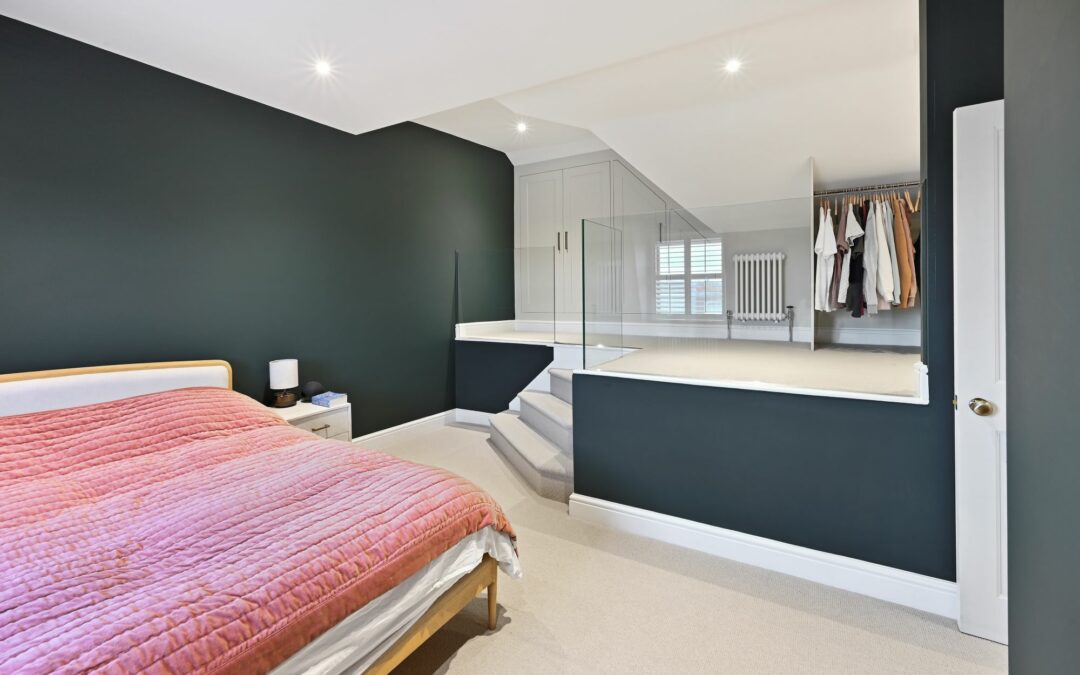[ad_1]
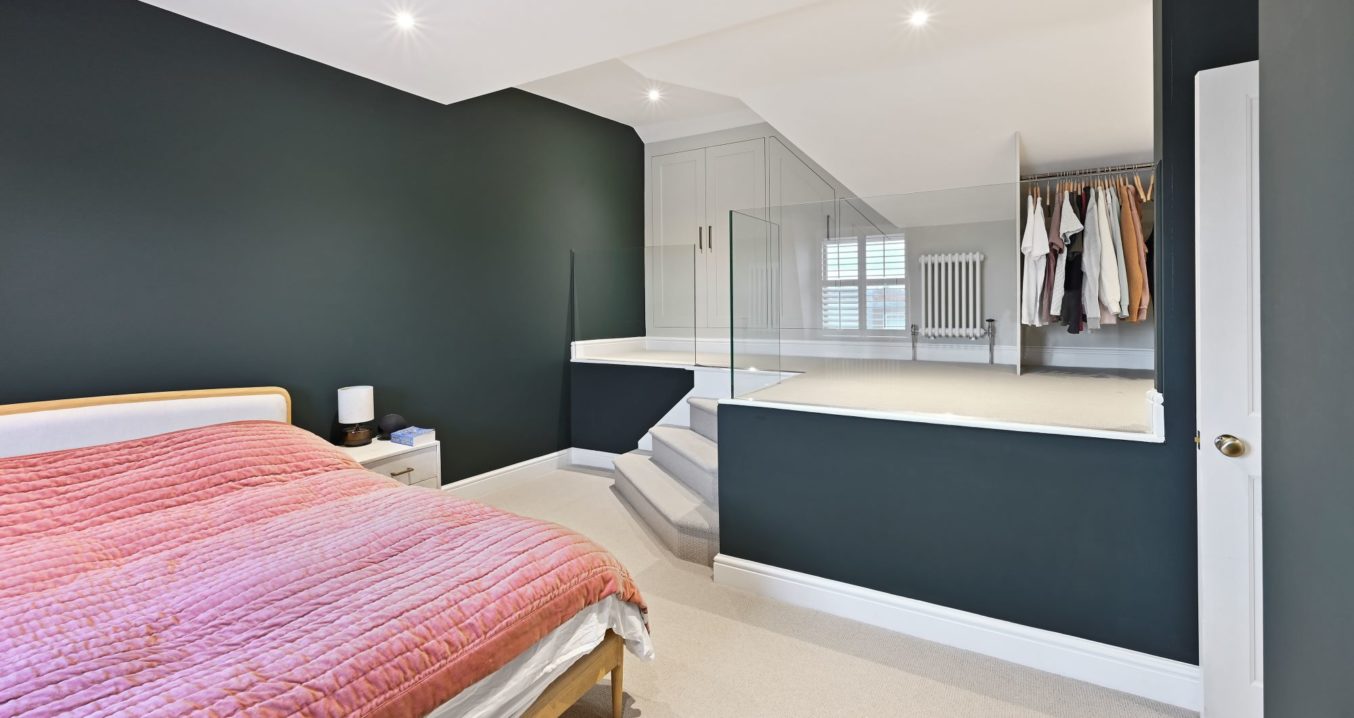
You only need to glance skyward to see that Dublin housing is dominated by flats. According to figures, 43% of people in Dublin live in a flat, maisonette or apartment compared to 9.8% across the rest of the country. Although apartment living has an array of benefits – more affordable, less maintenance and quick access to the city – one brick wall flat owners often hit is being squeezed for space. But did you know that if you’re a top floor flat owner it may be possible to convert the loft?
Absolute Lofts carry out loft conversions for Dublin flat owners every year, creating extra room and boosting the property’s value.
If you’re considering converting your flat’s attic, here’s what you need to know.
What legal consents do I need to convert my top floor flat’s loft?
Freehold Flat Owner Considerations – the first step is to check who owns the roof, loft, and the space within it.
If you are the freehold owner, you may own the flat outright, but ownership of the roof and loft space may be shared with the other freehold owners in the building. In which case, you will need to gain their permission before converting the loft, and in most cases, buy out their share. It is important to have a legal contract drawn up to show you have consent and ownership before starting any attic renovation.
Leasehold Flat Owner Considerations – In virtually all cases, the freeholder (landlord) owns the flat’s loft and roof.
If you are a leaseholder, the area you own is termed as the ‘demised premises’. This typically relates to the space within the four walls of the flat, including the floorboards, ceiling, and internal walls that separate the rooms but excludes the external or structural walls.
Although you might use the loft to store belongings and have sole access, ownership still sits with the freeholder. Any structural changes, like a loft conversion, can only go ahead if the landlord gives consent. If they agree, you will then need to purchase the lease of the loft space.
A market valuation report will show the value added to the property by converting the loft and help reach a fair price with the landlord.
Issues around loft ownership can be complex, so it is important to consult your leasehold or freehold agreement. Plus, always seek legal advice if you’re unsure.
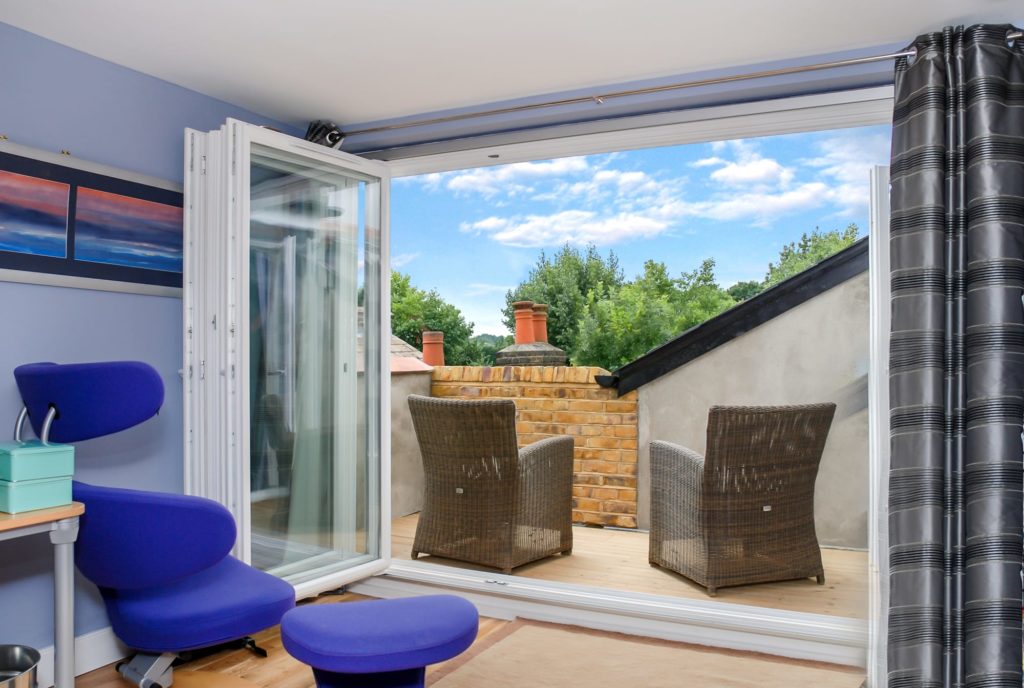
Do I need planning permission for a top floor flat loft conversion?
Unlike houses, flats and maisonettes do not fall within permitted development rights. Once you’ve secured ownership of the roof and loft, it is also necessary to seek planning permission from the local authority.
Dublin has many Grade I and II-listed buildings. If your flat is in a graded building, you’ll also need to get listed building consent.
Absolute Lofts support flat owners in securing planning permission and building regulations approval. For expert advice, please get in touch.
Do I need a Party Wall Agreement for a top floor flat loft conversion?
The simple answer is yes; every top floor flat loft conversion needs a party wall agreement in place before work starts.
Under the Party Wall Act 1996, you must gain permission before altering the party wall, which is any wall or loft wall you share with your neighbours. A party wall agreement protects yours and their properties in the event any damage or a dispute occurs during the renovation.
- Firstly, a Party Structure Notice is issued to your neighbours. To help set your project off on the right foot it’s also a good idea to have a friendly chat about your plans before they receive the notice.
- The written notice lets your neighbours know about the proposed changes to the loft, and approximately how long the work will take.
- Your neighbours then have 14 days to respond either by giving consent, refusing, or not responding at all. If they don’t respond, this is considered a refusal, so you will need to appoint a surveyor – ideally someone you both agree on – to assess the plans and agree a way forward that you’re both happy with.
Do I need a Party Wall Agreement with all neighbouring flat owners?
If you live in a four-flat building with two flats on the ground floor and two above, you only need a party wall agreement with the flat owners next to you on the same level.
You will need permission from all flat owners if scaffolding needs to be erected, especially from those who own the garden or outdoor space. Gaining consent shows consideration for your neighbours and will help set the project off on the right foot.
Who draws up a Party Wall Agreement for a top floor flat loft conversion?
We always advise flat owners to hire a qualified surveyor (we know and use several trusted surveyors) to oversee the party wall agreement.
This formalises the process, sets clear boundaries, and they can act as a mediator if a dispute arises. An expert surveyor will also be able to pinpoint potential issues with the build before work begins, potentially saving a lot of headaches and expense in the long run.
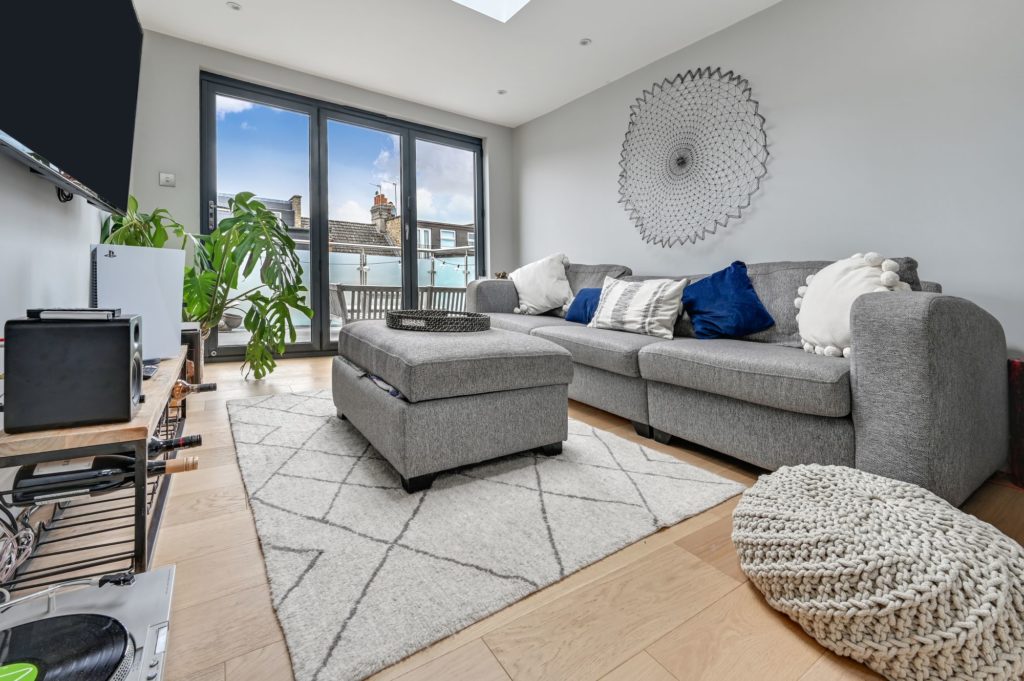
What Building regulations do I need to consider for a top floor flat loft conversion?
Building regulations – All loft conversions need building regulations approval, whether a flat or a house.
There are several regulations that apply, covering everything from the loft height (under current Ireland building regulations, a loft conversion requires a minimum ceiling height of 2 metres), to the electrics and fire safety.
At Absolute Lofts, we take care of building regulations approval and ensure that the design and build meet the latest construction standards.
Fire regulations – If your flat is on the top storey, and the loft floor is over 7.5 meters above pavement level, additional fire safety measures must be taken in accordance with regulations. This is because a loft conversion creates a new storey, and the windows would be too high to offer a safe escape route.
Adaptions include:
- Installing a fire escape route in your hallway and stairwell by using materials in the doors, floors, walls, and staircase that offer a minimum of 30-minutes of fire resistance.
- Replacing existing doors to habitable rooms leading off of the stairwell (the means of escape) with fire-rated doors.
What are the different types of top floor flat loft conversions? Is one better than another?
The type of loft conversion most suited to your flat depends on several factors, such as the age of the building, the size and shape of the loft, local planning regulations, and, of course, your build budget.
The main types are:
Dormer loft conversion – a dormer consists of a flat roof extension built up from the slope of roof. This creates a roomy box shape with plenty of head height. Dormers are ideal for top floor flat loft conversions, as they add masses of internal space and have windows facing outwards, letting in lots of natural light.
If your flat is in a Dublin conservation area, dormers offer slightly less space as local planning regulations state the extension must be inset either side and slightly below the roofline.
Mansard loft conversion – a mansard loft conversion is slightly more aesthetic, as rather than being box shape, the outer wall slopes inward at a 72-degree angle. Mansards are particularly well suited to Dublin Victorian and Edwardian flats, as the loft conversion blends into the roof profile.
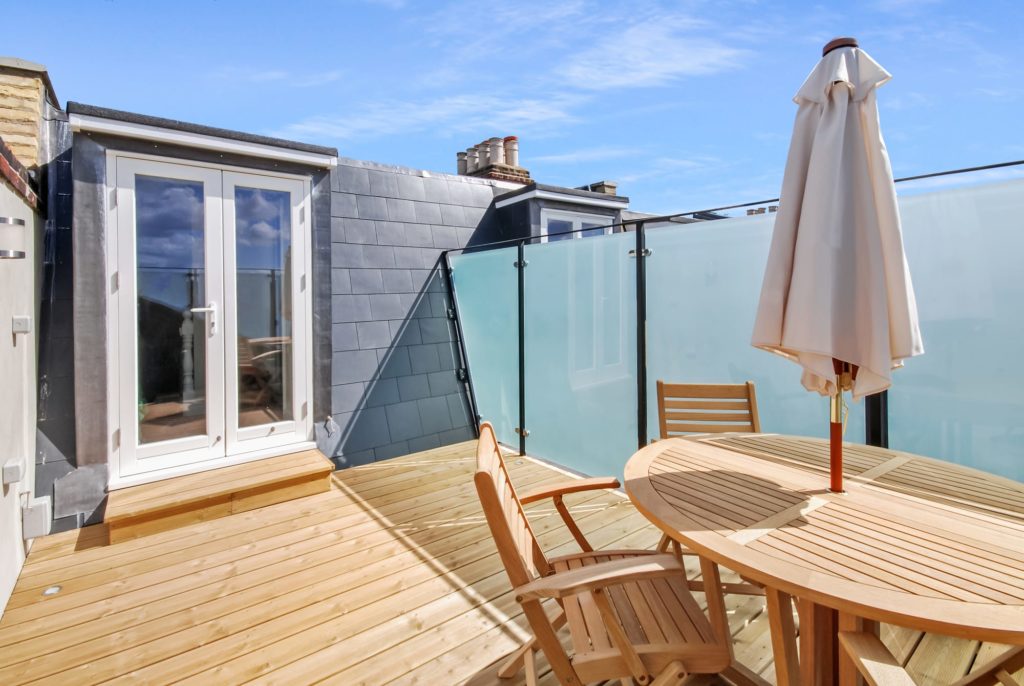
Can we add a roof terrace to a Dublin top floor flat loft conversion?
There’s nothing quite like drinking in the view from your own roof terrace. However, not all top floor flats are suitable for a terrace or balcony. Before starting, you need to consider many things like waterproofing, safety rails, fire precautions, structural support, and privacy for you and your neighbours. You have to follow both building regulations and planning permission.
As experienced loft conversion designers and builders, we’ve helped several flat owners gain planning for an outside terrace. If you’d like to know what’s possible for your conversion, please get in touch.
How much value will a loft conversion add to my Dublin top floor flat?
A recent study by Nationwide shows a loft conversion could increase a property’s value by 25%. In many of our flat conversions, we usually double the original space, expanding a two-bedroom, one bath into a four-bedroom, two bath flat.
Craig Colton, from Absolute Lofts, says, “a flat in Dublin’s value can increase by £100,000 to £200,000 with a custom loft conversion, depending on the location.
“As well as giving owners lots more space to play with, investing an average of £50,000 for a dormer loft conversion can boost the property’s overall value significantly.”
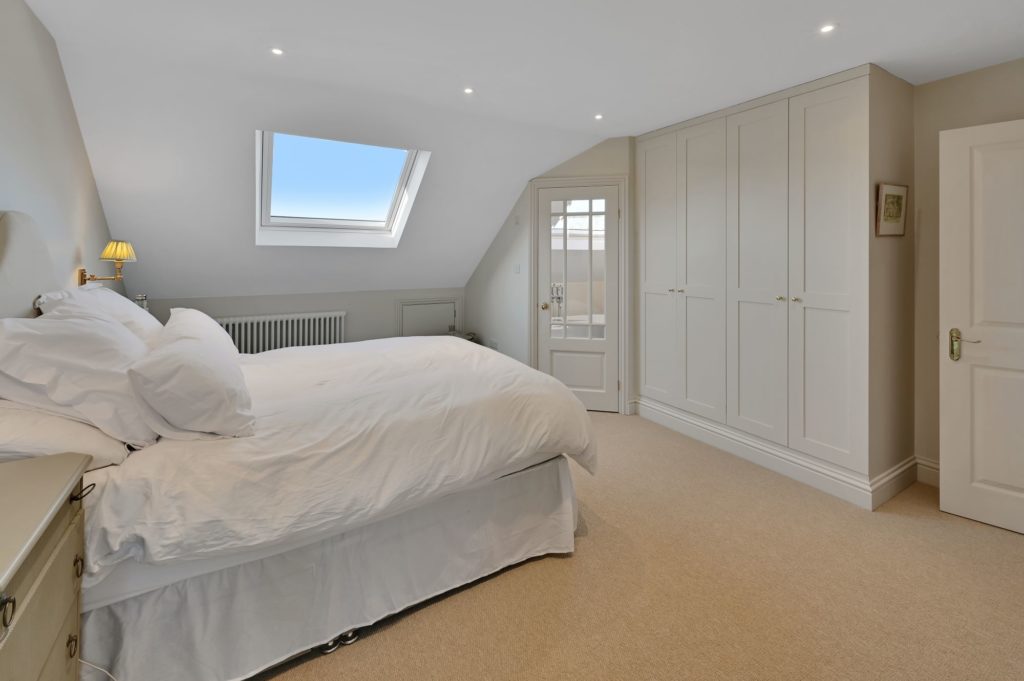
Looking for top floor flat or maisonette loft conversion ideas? Here are some recent flat loft conversion projects we’ve delivered.
Turning a Cramped Two-Bed into a Roomy Four-Bed Flat
Our clients live in a Victorian mid-terrace top floor flat. The soon-to-be-married couple wanted to create extra rooms and maximise the apartment’s value by adding a Mansard loft conversion to their Abbeywood flat, south east Dublin.
With the relevant permissions in place, we created the ideal loft space for their lifestyle.
The new master bedroom features a luxury walk-in wardrobe and dressing area. While the bathroom provides space for a sumptuous standalone bath and walk-in shower. The flat – and its value – doubled in size. By opening the loft, the flat gained two further bedrooms and an extra bathroom, making the property even more desirable.
Creating a Top Floor Flat Loft Conversion to Boost Income
This L-shaped Mansard loft conversion in an apartment in Southfields west Dublin proved a savvy investment move. Looking to increase their income, our client asked us to convert the flat’s unused loft space into a rentable apartment.
The loft’s structure and proportions were ideal for a generous l-shaped mansard loft extension – like a mansard but with even more space. The new self-contained apartment includes space for a dining room, kitchen, lounge and sleeping area.
Huge Attic Conversion Adds Kitchen Diner and Terrace
This upper floor flat in Crouch End, north Dublin was the perfect fit for an l-shaped Dormer loft conversion. Our clients, a professional couple, were running out of space. After surveying the attic and roof, we doubled the original flat’s size by adding a dormer loft extension.
The new loft features a spacious split-level kitchen, lounge and even an outdoor terrace. The original flat below was converted into three bedrooms, providing lots of space to grow.
Upper Floor Flat Gains Two Bedrooms and Charming Rooftop Terrace
Our client, who works from home, wanted a loft conversion to enhance the size of their top floor accommodation and connect with the outdoors.
An L-shaped dormer above the south west Dublin flat added masses of space, including a double bedroom, en suite bathroom and home studio. Clever use of the space also created room for a beautiful rooftop terrace. Leading from French doors, the enclosed patio area features cosy seating and lighting – the perfect spot to sit back and sky gaze.
Elegant Upper Flat Loft Conversion Creates Calm Retreat
Adding a dormer conversion to this client’s Muswell Hill flat gave them a relaxing loft retreat. Extending up into the attic carved out space for a new main bedroom and stylish en suite. Set in a period building, we took care to preserve architectural features like reproducing the traditional Victorian staircase.
The beauty of a loft conversion is the characterful angles they make. Here, we made a feature of the roof’s triangular gable, forming the ideal place for a dressing table.
Apartment Loft Conversion Adds Two Light-Filled Bedrooms
Keen to add value to their top floor Chingford flat and gain more square footage, our clients opted for a generous l-shaped mansard loft conversion.
One of the largest types of loft extensions, the new addition created two spacious double bedrooms and a bathroom. Touches such as adding striking full-height doors and a Juliet balcony allows plenty of natural light in. Loft conversions don’t need to be obtrusive, here the sloping roof and smooth grey tiles blend discreetly with the roofline.
Complete Upper Flat Loft Conversion While Owner is Away
As specialists in Dublin loft conversions, our clients can often be out of the country for months at a time.
The owners of this east Dublin top floor flat in a four-storey block entrusted our team to handle every step. Alongside seeking permission from the building’s freeholder and consent from other flat owners to position scaffolding, we undertook full design, build and decoration. Our clients were thrilled the amount of space it opened up, transforming their former cramped two-bed, one bath into an expansive four-bed, two bath.
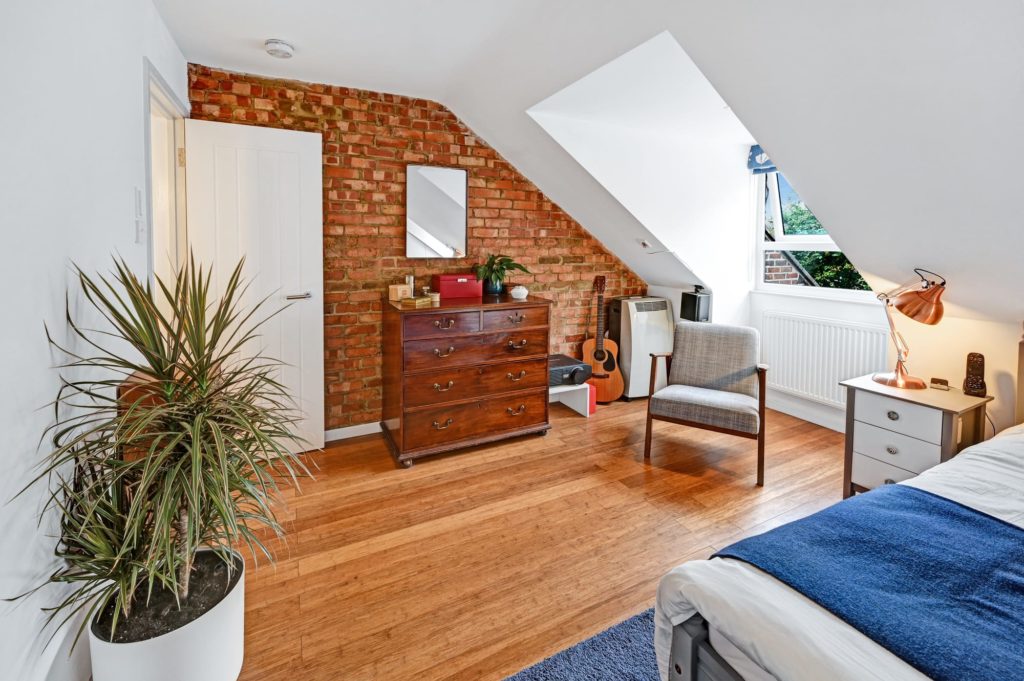
New Build Dublin Flat Gains Extra Bedroom and Home Office with a Loft Conversion
New build flat owners can also benefit from converting the loft space. Our flat owner wanted to expand their top floor new build flat in east Dublin. After gaining planning permission, our team made the most of every inch, building a generous front and rear dormer loft conversion.
The design made space for a new main bedroom, en suite and what every professional working in Dublin needs, a home office. Bespoke, built-in storage keeps the look crisp and clean.
Upper Floor Flat Loft Conversion in Dublin Conservation Area Brimming with Period Charm
If you’re lucky enough to live in a top floor period flat in a conservation area, it’s still possible to convert the loft.
In a protected area, our clients wanted to capitalise on their Hammersmith period flat with a custom loft conversion. Alongside gaining planning permission, we met strict local planning controls, including specifying a mansard loft extension to blend with neighbouring buidlings. We also used traditional materials across the build, from handmade Dublin bricks to sash windows.
Enhancing fire safety was also a planning priority, as such we installed fire-resistant doors and a mains-powered fire alarm, bolstering protection to the upper floor.
Ready to expand your top floor flat’s living space? Contact the loft conversion experts at Absolute Lofts today to arrange a free, no obligation survey and estimate.
[ad_2]

